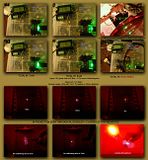- Joined
- Sep 16, 2007
- Messages
- 3,660
- Points
- 113
Whether or not IR is really dangerous has been a question that has been debated many times before.
My goal here is to clarify the issue with facts.
For this I used my Laserbee I to test the power of the IR leakage emitted from a very common type of green laser used today, the O-like 150mW module. The Laserbee I is a thermal power meter, so the power measurement is not affected by wavelength.
The tests were done with 1.2V NiMH batteries for lower power levels closer to 100mW. I thought this would be a good "in between" measurement to cover some lower power greens and also the medium power greens.
I used my cellphone camera to take the images in which the IR is visible.
Note: The Laserbee I can only read down to 5mW, so when it reads 0mW, the total power can be no greater than 4.99mW.
The results are below.
I hope these results will help clear some of the fog around the subject.
I would have liked to do these tests with several different lasers but this was the only unfiltered one I have at the moment. If anyone else has more information, please feel free to contribute.
EDIT: I would like it if this could be stickied either here or in the General section because I think this could be helpful information for n00bs and some older members alike... I just don't know how that gets done...
Thanks all for reading.
THUMBNAIL:

My goal here is to clarify the issue with facts.
For this I used my Laserbee I to test the power of the IR leakage emitted from a very common type of green laser used today, the O-like 150mW module. The Laserbee I is a thermal power meter, so the power measurement is not affected by wavelength.
The tests were done with 1.2V NiMH batteries for lower power levels closer to 100mW. I thought this would be a good "in between" measurement to cover some lower power greens and also the medium power greens.
I used my cellphone camera to take the images in which the IR is visible.
Note: The Laserbee I can only read down to 5mW, so when it reads 0mW, the total power can be no greater than 4.99mW.
The results are below.
I hope these results will help clear some of the fog around the subject.
I would have liked to do these tests with several different lasers but this was the only unfiltered one I have at the moment. If anyone else has more information, please feel free to contribute.
EDIT: I would like it if this could be stickied either here or in the General section because I think this could be helpful information for n00bs and some older members alike... I just don't know how that gets done...
Thanks all for reading.
THUMBNAIL:

Last edited:




